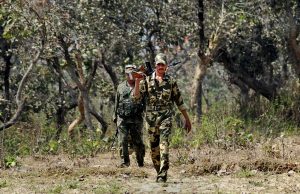In March this year, 17 security personnel were killed in a Maoist ambush on a joint team of forces in the Sukma district of Chhattisgarh’s Bastar division. The attack bore signs of a complex, well-planned ambush, with one sub-group of security elements being drawn into the Maoist kill zone by sporadic fire where they were picked off by insurgents occupying the high ground. Incidents of this kind are far from a novelty in the Maoist hotbed of Bastar; multiple high-casualty attacks have been recorded in and around Sukma in the past decade.
Yet, the March ambush was a reminder of the Maoist movement’s survival in the face of an ever tightening security grid based on unofficial doctrinal revisions and strategic redirection. To be clear, there is no denying that the insurgency has largely weakened since the period between 2004-10, with insurgents no longer controlling as much territory as they used to and levels of violence seeing a drop due to several factors. That said, the armed uprising, which began as a people’s movement against oppression by the landed class in Naxalbari, West Bengal in 1967, continues to exact a deadly toll on the security establishment as well as the locals inhabiting large parts of central India.
From the insurgents’ standpoint, the COVID-19 pandemic has complicated matters, as indicated by the surprisingly low levels of violence between March and June. This is in contrast with the annual uptick in insurgent plots during this period as part of their Tactical Counter Offensive Campaign (TCOC), wherein the guerrillas attempt to organize bold attacks and push the envelope of their offensive capabilities before the onset of the monsoon season. In this regard, while the general trend has already been in favor of the security establishment over the past few years, COVID-19 likely impacted the insurgents’ supply lines. Reports quoting security officials suggest that the nationwide lockdown greatly constrained the guerrillas’ acquisition of essential supplies like grains and medicines.
The interdiction of movement and goods across state borders also likely impinged on the supply of ammunition and explosives to a certain degree, especially from Maoist arms factories in Jharkhand and Chhattisgarh. On the funding side of things, Maoist units to the level of dalams, or squads, are heavily dependent on the extortion of local communities, government functionaries, and industrial enterprises in their area of operations, and the COVID-19-related restrictions most likely caused disruptions in these networks. Despite the absence of conclusive data, it is almost certain that Maoist cadres in various operational zones are also battling the spread of the infection. An indicator of this may be the extent of disease spread among security forces deployed in Maoist-affected zones like Dantewada in Chhattisgarh.
However, this does not translate to a diminished threat perception by any means. For starters, Maoist elements are expected to take advantage of the lull in operations to regroup in traditional strongholds like the Andhra-Odisha Border region and Bastar in Chhattisgarh, more so since their expansion in relatively new zones like the Maharashtra-Madhya Pradesh-Chhattisgarh trijunction will be slower in the coming months. Additionally, the change of Maoist leadership in late 2018 to Basavaraj, the former head of the Maoists’ Central Military Commission, has seen the growing return to increasingly aggressive tactics, such as attacks on mainstream politicians, large-scale IED-based plots, and multi-pronged ambushes.
The ongoing pandemic is not expected to impact this operational outlook, and high-visibility incidents of that sort may be seen irrespective of security forces’ gains. The elevation of commanders with greater tactical acumen and a pronounced sense of belligerence, such as Hidma, who was made the overall commander of Maoist operations in Chhattisgarh in January, will also feed into the increased risk of symbolic, large-scale attacks in vulnerable areas like the Bastar division. These are also areas where elevated levels of local disaffection have aided Maoists – something that will only be compounded in the coming months due to the economic troubles brought on by COVID-19.
The local disenchantment which Maoists feed off primarily stems from the central government’s disproportionate reliance on kinetic responses to the insurgency despite the constant talk of “winning hearts and minds,” a preference which has been replicated by various states combating the Maoist menace in their federally independent capacities. This unsatisfactory pattern is expected to stay its course due to the absence of a coherent long-term state strategy and considering that a population-centric counterinsurgency approach is all too often undercut by the influence of disparate on-ground actors — such as local politicians and industrial sections — who collude with and cede space to insurgents based on their divergent agendas. Paradoxically, the more authorities turn to force saturation and related tactics, the longer lease of life the Maoists get. This is clearer in the context of the tragic history of underdevelopment and alleged state heavy-handedness in Maoist-prone tribal areas, which tends to inform patterns of insurgent recruitment.
Tarun Nair is an intelligence analyst from Mumbai, India with an interest in security and geopolitics in the Asia-Pacific region. He tweets at @nair_tarun1.

































